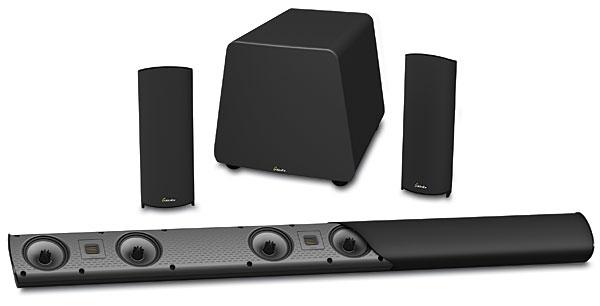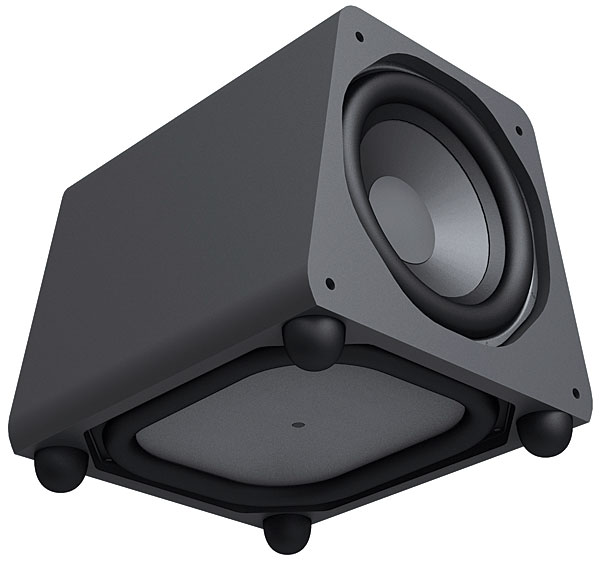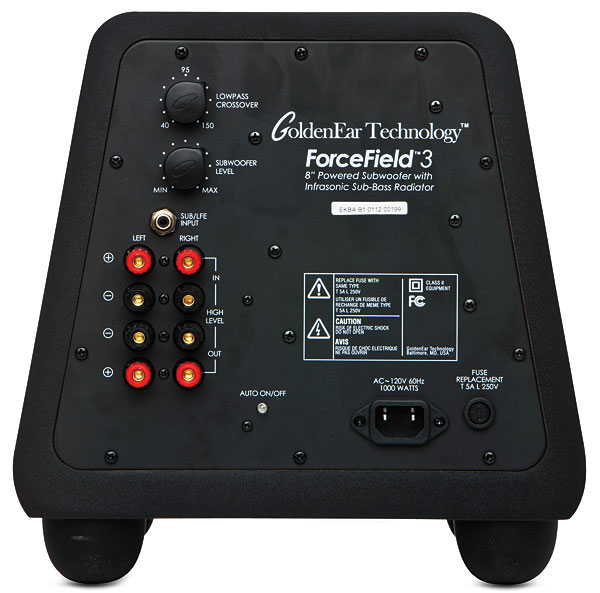GoldenEar Technology SuperCinema 3D Array Soundbar System

Women. They’re the problem. They’re the ones who have ruined home theater for all the manly men out there whose only vice was reclining in front of a set of towering speakers that dominated the room like a pair of long-faced Easter Island monoliths—speakers so masculine, they used testosterone instead of ferrofluid to cool the voice coils and were topped with skeleton-ugly horn tweeters so efficient Joshua could have used them to bring down the walls of Jericho the first day (before lunch!). For additional aural excitement, in a front corner of the room, openly begging for attention and not girlishly hiding behind a couch or doing double duty as a plant stand, would be a massive subwoofer with a magnet assembly so powerful that localized rooftop occurrences of the aurora borealis would happen from time to time. Techs from the local hospital would often bring patients to the house and use the subwoofer for testing when the lab’s MRI machine needed repair. But no more. The man cave has been emasculated and replaced by the female grotto, complete with bowls of potpourri and seating geometries that would make Euclid weep with grief. The coup de grâce, however, the fatal blow to any home theater’s manhood, is the now near-obligatory soundbar. Long and falsely phallic, it mocks the real men in the room as it preens itself under the flat-panel HDTV.
Hyperbole and blatant sexism aside, soundbars simply aren’t the most macho-looking home theater speakers. Sadly, that’s not their only claim to shame. The typical experience of buying a soundbar, taking it home, and then watching a movie is the home theater equivalent of going on a blind date with a woman who has the body of Charlize Theron—only to crushingly find out she has the voice of Roseanne Barr. Mind you, I’m not saying soundbars by definition have to sound like crap. Some of the latest—and most expensive—soundbars sound surprisingly good, which is quite heartening for those of us who believe sound is as important to a movie as the picture is. My point, though, is that the design of too many soundbars is driven by form (it has to be thin, fit under the TV, and match the cosmetics), while function (oh, it has to sound great, too?) gets to hitch a ride in the trunk.
When you think about it, considering all the obstacles the laws of physics put in the way, it’s amazing that any soundbar can even get within spitting distance of sounding good. After all, it’s a daunting engineering task to work with a speaker cabinet that’s at most 4 inches deep with left- and right-channel drivers mounted a paltry 36 inches (or less) apart—then the drivers for the center channel somehow have to get shoehorned in between. And that’s just for an LCR soundbar. Up the difficulty rating substantially if you’re designing a soundbar that offers a simulated 5.1- or (gasp!) 7.1-channel surround sound experience.
Breaking the Sound Bar Barrier
GoldenEar Technology’s SuperCinema 3D Array is the young company’s first LCR soundbar, although it already sells the flat-panel-friendly, on-wall SuperSat 50 (and SuperSat 50C horizontal center-channel) speaker. So far, just about every model GoldenEar has introduced has earned rave reviews, especially the superlative Triton Two towers, as well as the smaller—but only slightly less stellar—Triton Three towers. The Tritons are two toweringly incredible tough acts to follow; and considering the overall track record so far, you could say that GoldenEar has definitely set the sound bar pretty darn high—maybe higher than a soundbar can reach.

The SuperCinema 3D Array is a passive LCR soundbar, which means it requires an A/V receiver for the audio processing and amplification—and it reproduces only the information from the front three channels. There’s no additional drivers built in to assimilate and throw the surround channels in some way to create the impression of having discrete surround speakers. Passive LCR soundbars aren’t quite as rare as finding a Sasquatch enjoying the free Wi-Fi at Panera while reading The National Enquirer online and drinking a pumpkin spice latte, but the general trend is now toward soundbars with built-in amplification, multichannel processing, and wireless subs—the type of soundbar ideally suited for someone who hates wires, cables, and components yet wants something that sounds better than the crappy little desiccated pieces of partridge droppings that masquerade as speakers in just about every flat-panel TV in the known universe. If you’re looking for an all-in-one, plug-and-play, instant-TV-upgrade soundbar (of which there are a couple of good ones just hitting the market), this isn’t it.
To finish out a 5.1-channel system built around the $1,000 SuperCinema 3D Array, GoldenEar Technology shipped a $500 pair of the company’s smallest monitor speaker, the SuperSat 3, along with the soundbar. As with any slim, hang-on-the-wall speaker, the SuperCinema 3D absolutely needs a subwoofer; and, in this case, GoldenEar sent the smaller of the company’s two subwoofers, the $500 ForceField 3. All told, the speaker system costs just under $2,000, which is a bit pricey when it comes to most of the self-contained surround soundbars. But it’s quite reasonable as far as respectable home theater speaker packages go.
Cosmetically, the tightly woven black cloth grille and graceful curves of the SuperCinema 3D’s 49-inch-long, extruded-aluminum, piano-black-gloss cabinet match the rest of the speakers in the GoldenEar line, especially the SuperSat 3s. Helped by its minimal height (4.75 inches) and depth (2.75 inches), the SuperCinema 3D is simultaneously both neutral and classy when mounted under almost any—thick or thin—flat-panel HDTV. The svelte SuperSat 3s look like 12-inch-tall vertical versions of the SuperCinema 3D and become mostly inconspicuous when wall-mounted (using the speakers’ keyhole slots). While the relatively small ForceField 3 subwoofer doesn’t come with a cloak of invisibility, it occupies only a little over 1 square foot of floor space wherever you decide to put it.
For a more in-depth look at the GoldenEar monitors and sub, read Mark Fleischmann’s November 2011 review of the SuperCinema 3 system he took for a spin. (Spoiler alert: Overall, with a caveat or two, Mark thought it was “an awe-inspiringly great-sounding system.”)

Remove the black cloth grille from the front of the SuperCinema 3D, and you’ll find six of GoldenEar’s 4.5-inch drivers employing cast spider-leg baskets and multi-vaned phase plugs spaced along the front baffle. There are also three of the company’s fantastic High-Velocity Folded Ribbon (HVFR) tweeters. These tweeters, if you’re not familiar with them, use multi-folded planar magnetic diaphragms that squeeze together and pull apart much like the sides of an accordion—although to a much smaller degree. One of the touted benefits of the design is phenomenal transient response; and, in my opinion, it’s one of the primary reasons why so many of the other GoldenEar speakers I’ve heard sound so spectacular.
A Passive-Aggressive Approach
At first glance, the driver configuration looks fairly standard, with each of the three channels (left, center, right) having its own HVFR tweeter flanked by a 4.5-inch woofer on each side. Closer inspection, though, reveals that the outermost woofers for the left and right channels sit about an eighth of an inch closer to that channel’s HVFR tweeter than do the inner-mounted midbass drivers. The reason for this is that those outer drivers aren’t there to add to the sound of what would appear to be their respective channels. They’re there to cancel sound from the opposite channels.
Although the GoldenEar SuperCinema 3D has no active circuitry to create surround sound, there is a bit of passive technology in the soundbar that’s meant to aggressively cancel out what’s known as interaural crosstalk. You might think “interaural crosstalk” is the garbled sound you make when the dentist invariably asks you a question right after he’s shoved several fingers and a couple of dental tools into your mouth, but it’s a term for what happens when sound from the right speaker crosses over your nose and finds its way into your left ear—and vice versa with the left channel. This crosstalk can take a beautifully marbled rib eye steak of a great recording—with all of its juicy tenderness, subtle flavors, and amazing width and depth—and grind all those carefully dry-aged acoustic spatial cues into a lump of cheap, hormone- and antibiotic-laden hamburger that’s already past its sell-by date. Interaural crosstalk becomes especially problematic when the main left and right speakers are placed fairly close together, which is exactly the situation in any soundbar less than 10 feet in width (in other words, virtually all of them).























































